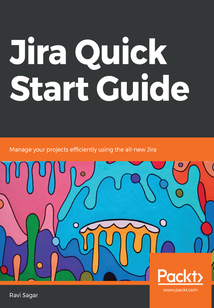舉報 

會員
Jira Quick Start Guide
Jiraisanissuetrackerandprojectmanagementsystem.Withtheirlatestrelease,theJirateamhasnowexpandedtheiruserbasetoagileteamsaswellasbusinessteams.ThisbookprovidesacomprehensiveexplanationcoveringallmajorcomponentsofJira,includingJiraSoftware,JiraCore,andJiraServiceDesk.ThisbookstartswithanintroductiontoJira'suniquefeaturesandhowitcanbeusedasanissue-trackingtool.ItwillthenteachyouabouthowanewprojectiscreatedbyaJiraadministrator,whatresponsibilitiesthereare,andusingcorrectandrelevantschemesinyourproject.Youwillthenlearnhowtoconfigureprojectworkflowsandfieldsforprojectscreens.YouwillunderstandthevariouspermissionsusedinprojectsandtheimportanceofprojectrolesinJira.Then,thebooktalksabouttheconceptsofversionsactingasmilestonesandusingcomponentswhenhandlingissuesinyourprojects.Itwillthenfocusonanalysingdatausingbuilt-inreportsandcreatingdashboardsinJira.Attheend,itwilldiscussvariousbestpracticesforusersaswellasprojectmanagersorprojectadministrators.
目錄(174章)
倒序
- coverpage
- Title Page
- Copyright and Credits
- Jira Quick Start Guide
- Dedication
- About Packt
- Why subscribe?
- Packt.com
- Contributors
- About the author
- About the reviewer
- Packt is searching for authors like you
- Preface
- Who this book is for
- What this book covers
- To get the most out of this book
- Conventions used
- Get in touch
- Reviews
- Introducing Jira
- What is Jira?
- Jira Core
- Jira Software
- Jira Service Desk
- The problems Jira solves
- Challenges and problems that Jira solves
- Lack of flexibility
- Difficulty in customization
- Difficulty in adoption by teams
- Extensive training to learn the tool
- Expensive
- What are the main benefits of Jira?
- Standard tool for teams of all sizes
- Simple licensing model
- Lightweight tool
- Low maintenance
- Ease of use and intuitiveness
- Increased productivity
- Better visibility
- Integration with other tools
- Marketplace apps
- A RESTful API for limitless possibilities
- Atlassian Community
- How to decide which application to use?
- Deployment options
- Cloud
- Server
- Data Center
- Summary
- Getting Started with Jira Core and Basic Usage
- Getting started with Jira
- Planning your Jira installation
- How many users will be using Jira?
- What problems are you trying to solve with Jira?
- Which application and what apps would you need?
- How many projects do you want to create in Jira?
- What will be the projected usage in six months and one year from now?
- Integration with other tools
- Choosing a deployment
- Setting up a Cloud instance
- Using Jira Core for business teams
- Creating a new project
- Working on a Jira Core project
- Summary
- Activity
- Statistics
- Board
- Issues and filters
- Reports
- Working on an issue in a Jira Core project
- Summary
- Using Jira Software for Development Teams
- Using Jira Software for development teams
- Enabling Jira Software
- Overview of Agile concepts
- What is Agile?
- Scrum and Kanban methodologies
- Key Agile concepts
- Roles in Agile
- Is Jira suitable for development projects?
- Scrum board
- Creating a sample Scrum project
- Populating ranking and estimating a backlog using story points
- Planning and creating sprints
- Configuring swimlanes card colors edit card fields and quick filters
- Swimlanes
- Card colors
- Card layout
- Quick filters
- Jira Software reports
- The Burndown Chart
- The Velocity Chart
- Kanban board
- Setting up a Kanban board
- Column constraints
- Summary
- Using Jira Service Desk for Help Desks
- Using Jira Service Desk for help desks
- Enabling Jira Service Desk
- Overview of Helpdesk
- Basic features of any help desk
- Help desk processes
- Different ways to raise tickets
- Creating a Jira Service Desk project
- Using Jira Service Desk
- Customer portal
- Queues
- Customer permissions
- Configuring Jira Service Desk
- Request types
- Portal settings
- Email requests
- Satisfaction settings
- Knowledge base
- SLAs
- Automation
- Jira Service Desk reports
- Workload
- SLA goals
- Satisfaction
- Requests deflected
- Requests resolved
- Created versus resolved
- Time to resolution
- SLA met versus breached
- Incidents reported by priority
- Summary
- Jira Schemes and Configuring Project Workflow
- The various types of user in Jira
- User
- Project administrator
- Jira administrator
- Overview of various schemes in Jira
- Issue type schemes
- Workflow schemes
- Issue type screen schemes
- Field configuration schemes
- Permission schemes
- Notification schemes
- Customizing Jira workflow
- New status
- Creating a new workflow
- Summary
- Configuring Project Screens and Permissions
- Adding new custom fields in Jira
- Understanding Jira screens
- Using the custom field in our project
- Transition screens
- Working with permissions
- Summary
- Reports and Dashboards
- Jira Core reports
- Average Age Report
- Pie Chart Report
- Jira Software reports
- Burndown chart
- Velocity chart
- Jira Service Desk
- SLA success rate
- Satisfaction
- Creating and sharing dashboards
- Summary
- Best Practices
- Setting up a change control board
- Documenting your configurations
- Not creating too many statuses
- Not creating lots of custom fields
- Using contexts
- Using project roles over groups
- Not modifying default configurations
- Jira customization process
- Summary
- Other Books You May Enjoy
- Leave a review - let other readers know what you think 更新時間:2021-07-02 14:00:00
推薦閱讀
- 城鄉(xiāng)基本醫(yī)療保障服務(wù)均等化與福利分配效應(yīng)研究
- 香港玩具圖鑒
- 中國智庫索引
- 我們的言論(2015—2016)
- 增長:從細(xì)菌到帝國
- 大地牽龍
- 珠江論叢(2016年第1輯/總第11輯)
- 王應(yīng)麟學(xué)術(shù)評傳
- 引爆自律力
- “一帶一路”東道國就業(yè)政策與雇傭關(guān)系研究
- 中外疫災(zāi)治理史鑒:中國特色社會主義疫災(zāi)治理優(yōu)勢比較
- 跨文化能力綜合評價:理論與實(shí)踐
- 漂泊與返鄉(xiāng):跨國務(wù)工者的社會適應(yīng)
- 大學(xué)生GE閱讀(第3輯)
- 哈佛商學(xué)院最受歡迎的領(lǐng)導(dǎo)課
- 悅讀MOOK(第十七卷)
- 珠江論叢(2016年第4輯/總第14輯)
- 林紓:譯界之王
- 中亞國家的政治轉(zhuǎn)型
- 我們能做什么
- 中國管理智慧
- 江蘇社科名家文庫·葉南客卷
- 農(nóng)民工城市就業(yè):搜尋渠道與匹配路徑
- 接受與選擇:關(guān)于對象視域與人的主體性研究
- 斯坦福社會創(chuàng)新評論.11
- 我們的世界
- 分身:新日本論【一頁】
- 年輕人要知道的2000個社會常識
- 南大亞太評論(第6輯)
- 超掃描技術(shù)與社會認(rèn)知

